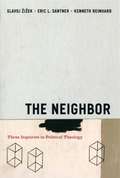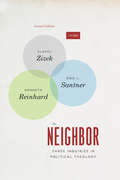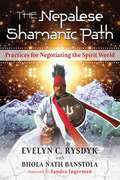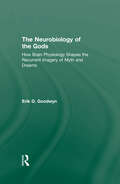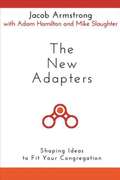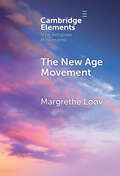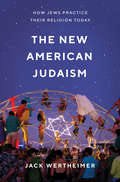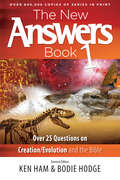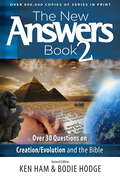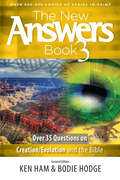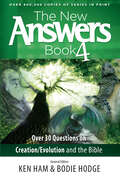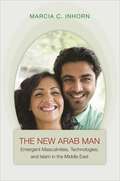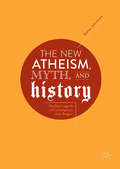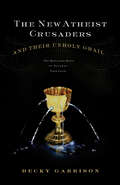- Table View
- List View
The Neighbor: Three Inquiries in Political Theology
by Slavoj Zizek Eric L. Santner Kenneth ReinhardIn Civilization and Its Discontents, Freud made abundantly clear what he thought about the biblical injunction, first articulated in Leviticus 19:18 and then elaborated in Christian teachings, to love one's neighbor as oneself. "Let us adopt a naive attitude towards it," he proposed, "as though we were hearing it for the first time; we shall be unable then to suppress a feeling of surprise and bewilderment." In The Neighbor, three of the most significant intellectuals working in psychoanalysis and critical theory collaborate to show how this problem of neighbor-love opens questions that are fundamental to ethical inquiry and that suggest a new theological configuration of political theory.
The Neighbor: Three Inquiries in Political Theology, with a new Preface
by Slavoj Žižek Eric L. Santner Kenneth ReinhardIn Civilization and Its Discontents, Freud made abundantly clear what he thought about the biblical injunction, first articulated in Leviticus 19:18 and then elaborated in Christian teachings, to love one's neighbor as oneself. “Let us adopt a naive attitude towards it,” he proposed, “as though we were hearing it for the first time; we shall be unable then to suppress a feeling of surprise and bewilderment.” After the horrors of World War II, the Holocaust, and Stalinism, Leviticus 19:18 seems even less conceivable—but all the more urgent now—than Freud imagined. In The Neighbor, three of the most significant intellectuals working in psychoanalysis and critical theory collaborate to show how this problem of neighbor-love opens questions that are fundamental to ethical inquiry and that suggest a new theological configuration of political theory. Their three extended essays explore today's central historical problem: the persistence of the theological in the political. In “Toward a Political Theology of the Neighbor,” Kenneth Reinhard supplements Carl Schmitt’s political theology of the enemy and friend with a political theology of the neighbor based in psychoanalysis. In “Miracles Happen,” Eric L. Santner extends the book's exploration of neighbor-love through a bracing reassessment of Benjamin and Rosenzweig. And in an impassioned plea for ethical violence, Slavoj Žižek’s “Neighbors and Other Monsters” reconsiders the idea of excess to rehabilitate a positive sense of the inhuman and challenge the influence of Levinas on contemporary ethical thought. A rich and suggestive account of the interplay between love and hate, self and other, personal and political, The Neighbor has proven to be a touchstone across the humanities and a crucial text for understanding the persistence of political theology in secular modernity. This new edition contains a new preface by the authors.
The Neighborhood of Gods: The Sacred and the Visible at the Margins of Mumbai (South Asia Across the Disciplines)
by William ElisonThere are many holy cities in India, but Mumbai is not usually considered one of them. More popular images of the city capture the world’s collective imagination—as a Bollywood fantasia or a slumland dystopia. Yet for many, if not most, people who live in the city, the neighborhood streets are indeed shared with local gods and guardian spirits. In The Neighborhood of Gods, William Elison examines the link between territory and divinity in India’s most self-consciously modern city. In this densely settled environment, space is scarce, and anxiety about housing is pervasive. Consecrating space—first with impromptu displays and then, eventually, with full-blown temples and official recognition—is one way of staking a claim. But how can a marginalized community make its gods visible, and therefore powerful, in the eyes of others? The Neighborhood of Gods explores this question, bringing an ethnographic lens to a range of visual and spatial practices: from the shrine construction that encroaches on downtown streets, to the “tribal art” practices of an indigenous group facing displacement, to the work of image production at two Bollywood film studios. A pioneering ethnography, this book offers a creative intervention in debates on postcolonial citizenship, urban geography, and visuality in the religions of India.
The Neighboring Church: Getting Better at What Jesus Says Matters Most
by Rick Rusaw Brian MavisNew Leadership network title, to be filled in at a later date by editor.
The Nemesis Charm (The Firebird Chronicles)
by Daniel Ingram-BrownThey say only the dead can cross a Threshold, the dead and those who have faced a Nemesis Charm.When Apprentice Adventurers, Fletcher and Scoop, discover their mother has fallen under the curse of a strange sickness, they prepare to sail for its source, a Threshold, a doorway to the world beyond the Un-Crossable Boundary.But they are not the only ones seeking to cross the Threshold. Their old enemy, Grizelda, has heard that beyond the Boundary lives a woman with the same power as the Storyteller. With the help of a monster made with an undead heart, she plans to cross the Boundary and steal that power for herself. If she succeeds, the Academy, the island and everything in Fletcher and Scoop's world will be hers.
The Nepalese Shamanic Path: Practices for Negotiating the Spirit World
by Sandra Ingerman Evelyn C. Rysdyk Bhola Nath BanstolaAn experiential guide to the shamanic spiritual practices of the Himalayas shared by a 27th-generation Nepalese shaman • Presents step-by-step, illustrated instructions for authentic Himalayan shamanic practices, including physical and spiritual healing, shamanic journeys, and ceremonies • Includes exercises to meet the ancestors in your shamanic lineage, techniques to use your voice as a shamanic tool, and practices for negotiating the spirit world safely • Details shamanic chants and rituals, how to create an altar, and the sacred objects of the shaman, along with exercises and techniques for using them properly There are few areas of our world where shamanic traditions have been preserved in their original context and form. Nepal is one of these rare and special places. In the shadow of the Himalayas Nepalese shamans, known as dhamis or jhankris, are still consulted for healing and divination, as well as for providing comfort and maintaining harmony. Following the devastating earthquake in Nepal in 2015, shamanic teacher Evelyn Rysdyk and 27th-generation dhami Bhola Nath Banstola decided it was time to safeguard Nepalese shamanic knowledge for future generations by recording the practices in a book. With this comprehensive, experiential guide to the ancient spiritual traditions of Nepal, Rysdyk and Banstola present step-by-step instructions for authentic Himalayan shamanic practices, including techniques for physical and spiritual healing, shamanic journeys, and advanced ceremonies, such as the Kalchakra Katne, a shamanic ritual for removing toxic energies from an individual. They include exercises to help you meet the ancestors in your shamanic lineage, techniques to use your voice as a shamanic tool, and practices for negotiating the spirit world safely. They detail shamanic chants and rituals, how to create an altar, and how to use the sacred objects of the dhami/jhankri, including the mala, the magic mirror, the drum, and the Khurpa, the shaman’s magic dagger. Rysdyk and Banstola also examine the importance of Nepalese cosmology in shamanic ritual and spiritual deities such as Hanuman, Garuda, and the Nagas. Illustrated with photos and Rysdyk’s artwork, the book also explores the history of Nepal, its culture and myths, and the different ways Nepalese shamans serve their communities. Written specifically to share the traditional Himalayan shamanic method with the Western world, this guide not only preserves these ancient teachings but also reveals how they are still relevant in the modern world.
The Neurobiology of the Gods: How Brain Physiology Shapes the Recurrent Imagery of Myth and Dreams
by Erik D. GoodwynWhere does science end and religion begin? Can "spiritual" images and feelings be understood on a neurobiological level without dismissing their power and mystery? In this book, psychiatrist Erik Goodwyn addresses these questions by reviewing decades of research, putting together a compelling argument that the emotional imagery of myth and dreams can be traced to our deep brain physiology, and importantly, how a sensitive look at this data reveals why mythic or religious symbols are indeed more "godlike" than we might have imagined. The Neurobiology of the Gods weaves together Jungian depth psychology with research in evolutionary psychology, neuroanatomy, cognitive science, neuroscience, anthropology, mental imagery, dream research, and metaphor theory into a comprehensive model of how our brains contribute to the recurrent images of dreams, myth, religion and even hallucinations. Divided into three sections, this book provides: definitions and foundations an examination of individual symbols conclusive thoughts on how brain physiology shapes the recurring images that we experience. Goodwyn shows how common dream, myth and religious experiences can be meaningful and purposeful without discarding scientific rigor. The Neurobiology of the Gods will therefore be essential reading for Jungian analysts and psychologists as well as those with an interest in philosophy, anthropology and the interface between science and religion.
The Neuroscience of Religious Experience
by Patrick McnamaraRecent technical advances in the life and medical sciences have revolutionized our understanding of the brain, while the emerging disciplines of social, cognitive, and affective neuroscience continue to reveal the connections of the higher cognitive functions and emotional states associated with religious experience to underlying brain states. At the same time, a host of developing theories in psychology and anthropology posit evolutionary explanations for the ubiquity and persistence of religious beliefs and the reports of religious experiences across human cultures, while gesturing toward physical bases for these behaviors. What is missing from this literature is a strong voice speaking to these behavioral and social scientists - as well as to the intellectually curious in the religious studies community - from the perspective of a brain scientist.
The New Adapters: Shaping Ideas to Fit Your Congregation
by Adam Hamilton Mike Slaughter Jacob ArmstrongLearn how new andyoung pastors from across the country are translating eight time-testedprinciples of church leadership. Adam Hamilton and Mike Slaughterintroduce each principle and discuss its importance in their ministries.Author Jacob Armstrong then shows how the principle works in newcontexts today. The New Adapters is full of energy, wisdom, and stories of hope."If you have wonderedwhat adaptive leadership looks like in practice, here it is. JacobArmstrong offers a road map for reaching the mission field, writing withhonesty, clarity, humility, and a heart attuned to the gospel. Heinvites us into a conversation with Adam Hamilton and Mike Slaughterthat is both substantial and practical. Gather a team around you and letthis book guide you to become New Adapters!" —Bishop Bill McAlilly,Nashville Episcopal Area of The United Methodist Church"The New Adaptersis a fantastic read — a clarion call for what is needed incongregations today. It will immediately start to shift the way youthink about ministry." —F. Douglas Powe Jr., Professor and AssociateDirector of the Center for the Missional Church, Wesley TheologicalSeminary, Washington, DC"A wonderful,hopeful, and practical volume for pastors, laity, and judicatory leaderswho want to facilitate and participate in adaptive change. Armstrongdraws wisdom from practitioners while refusing to offer a cookie cutterfor the church." —Elaine A. Heath, McCreless Professor of Evangelism,Perkins School of Theology, Southern Methodist University, Dallas, TX"This practical bookshould be in every church leader’s library. Armstrong invites us toreclaim our love for the church, practice Holy Spirit dependence, andbecome New Adapters in living the mission of Jesus Christ. Jacob iscalling us toward a new kind of church, one that gives me hope for thefuture!" —Bishop Mark J. Webb, Upper New York Episcopal Area of TheUnited Methodist Church
The New Age Movement (Elements in New Religious Movements)
by Margrethe LøøvThis Element introduces New Age religion. The New Age Movement is a loosely cohesive conglomerate of different spiritual currents with no common founder, leader, institution, dogma, or scripture. Because of its diversity, it may appear amorphous and incoherent at first sight. This Element emphasizes both the unity and diversity of the New Age. It approaches the phenomenon from three main perspectives: 1) the historical development of New Age religion, 2) ideas and practices associated with the New Age, and 3) the social organization of the New Age movement. It thus provides a wide-angle view that sketches out some of the main patterns that emerge from a mosaic of individual currents and actors associated with the New Age. It also highlights some of the differences within the movement by exploring some ideas and practices in depth.
The New American Anti-Semitism: The Left, the Right, and the Jews
by Benjamin GinsbergThe New American Anti-Semitism: The Left, the Right, and the Jews is a clarion call—not only to Jews, but to all Americans. As a nation, we must wake up and face the rising anti-Semitic threat and act accordingly.But that threat is not coming from its usual source. The most virulent form of anti-Semitism today, Ginsberg warns, is the result of toxic identity politics and anti-Israeli sentiment coming from today&’s political Left. Perhaps the most persecuted people in all of history, Jews have stood tall in the face of unprecedented persecution in all places, at all times. Their culture&’s rigorous emphasis on education and achievement catapults them, Ginsberg argues, to the upper echelons of the societies in which they live. But their success too often breeds resentment and jealousy, leading to an ugly anti-Semitism that has led, historically, to unspeakable violence. In this urgent new work, Dr. Benjamin Ginsberg—political scientist, professor, and bestselling author—exposes the ugly face of this new, progressive anti-Semitism (which is also thriving in Europe). To combat it, he urges American Jews to form new political alliances, particularly with evangelical Christians. The stakes of not doing so, says Ginsberg, are horrifically high—not only for the survival of the Jewish people, but for America&’s survival. After all, the Jews have contributed immeasurably to America&’s scientific, cultural, and economic achievements. Jews have been good for America; and America has been good to the Jews. But what once was so can change ... and Jews can never afford to forget their history. Read this book and learn: Why Jewish people have always persisted in the face of persecution; Why the new face of Jewish persecution has found a home on university campuses, Left-leaning media outlets, and other unlikely places; The high and horrible costs of anti-Semitism; The profound benefits of philo-Semitism; The details of the new alliances that must be made to ensure the continuing success of American Jews—and America itself; And much, much more... In this must-read tour de force, Ginsberg enlightens readers by tracing the history of the Jewish people—starting from the children of Abraham and ending with Jews today—and urging Jews and Americans to learn the lessons of that history. Now.
The New American Commentary Volume 33 - 1, 2 Thessalonians
by D. Michael MartinTHE NEW AMERICAN COMMENTARY is for the minister or Bible student who wants to understand and expound the Scriptures. Notable features include:* commentary based on THE NEW INTERNATIONAL VERSION;* the NIV text printed in the body of the commentary;* sound scholarly methodology that reflects capable research in the original languages;* interpretation that emphasizes the theological unity of each book and of Scripture as a whole;* readable and applicable exposition.
The New American Judaism: How Jews Practice Their Religion Today
by Jack WertheimerA leading expert provides an engaging firsthand portrait of American Judaism todayAmerican Judaism has been buffeted by massive social upheavals in recent decades. Like other religions in the United States, it has witnessed a decline in the number of participants over the past forty years, and many who remain active struggle to reconcile their hallowed traditions with new perspectives—from feminism and the LGBTQ movement to “do-it-yourself religion” and personally defined spirituality. Taking a fresh look at American Judaism today, Jack Wertheimer, a leading authority on the subject, sets out to discover how Jews of various orientations practice their religion in this radically altered landscape. Which observances still resonate, and which ones have been given new meaning? What options are available for seekers or those dissatisfied with conventional forms of Judaism? And how are synagogues responding?Wertheimer provides new and often-surprising answers to these questions by drawing on a wide range of sources, including survey data, visits to countless synagogues, and revealing interviews with more than two hundred rabbis and other informed observers. He finds that the majority of American Jews still identify with their faith but often practice it on their own terms. Meanwhile, gender barriers are loosening within religiously traditional communities, while some of the most progressive sectors are reappropriating long-discarded practices. Other recent developments include “start-ups” led by charismatic young rabbis, the explosive growth of Orthodox “outreach,” and unconventional worship experiences often geared toward millennials.Wertheimer captures the remarkable, if at times jarring, tableaux on display when American Jews practice their religion, while also revealing possibilities for significant renewal in American Judaism. What emerges is a quintessentially American story of rash disruption and creative reinvention, religious illiteracy and dynamic experimentation.
The New American Zionism
by Theodore SassonIn The New American Zionism, Theodore Sasson challenges the conventional view of waning American Jewish support for Israel. Instead, he shows that we are in the midst of a shift from a "mobilization" approach, which first emerged with the new state and focused on supporting Israel through big, centralized organizations, to an "engagement" approach marked by direct and personal relations with the Jewish state. Today, growing numbers of American Jews travel to Israel, consume Israeli news and culture, and focus their philanthropy and lobbying in line with their personal political viewpoints. As a result, American Jews find Israel more personally meaningful than ever before. Yet, at the same time, their ability to impact policy has diminished as they no longer speak with a unified voice.
The New Answers Book Volume 1: Over 25 Questions on Creation/Evolution and the Bible (New Answers Books #1)
by Ken HamEvolution...intelligent design...creation...or a little of all three? What do you really believe - and why does it matter to your life, your family, and your faith today? Christians live in a culture with more questions than ever - questions that affect one's acceptance of the Bible as authoritative and trustworthy. Now, discover easy-to-understand answers that reach core truths of the Christian faith and apply the biblical worldview to these subjects: Genesis the Days of Creation millions of years evolution dinosaurs carbon dating UFOs death & suffering Noah's Ark and Flood fossils starlight and time ...and much more. Explore these and other topics, answered biblically and logically in this book from the world's largest apologetics ministry, Answers in Genesis. Timely and scientifically solid, The New Answers Book offers concise answers from leading creationist Ken Ham and scientists such as Dr. David Menton, Dr. Georgia Purdom, Dr. Andrew Snelling, Dr. Jason Lisle, and many more.
The New Answers Book Volume 2: Over 30 Questions on Creation/Evolution and the Bible (New Answers Books #2)
by Ken HamWhat happens when you have more "hot" questions on the Bible and creationism than you can answer in one book? You create a second volume! The New Answers Book 2 explores over 30 exciting and faith-affirming topics, including: The fall of Lucifer and the origin of evil When does life begin (and why does it matter)? Is evolution a religion (and why should I care)? Archaeology, Egyptian Chronology, and the great flood Could early biblical figures like Noah really live to over 900 years of age? What was the Star of Bethlehem (and how did the wise men follow it)? The "Evolutionization" of our culture — including intelligent design, gay marriage, Hollywood movies, and more! Explore these and other topics, answered biblically and logically in this book from the world’s largest apologetics ministry, Answers in Genesis. Contributors include Ken Ham, Dr. Andrew Snelling, Dr. Jason Lisle, Dr. Elizabeth Mitchell, Dr. Danny Faulkner, Mike Riddle, and more.
The New Answers Book Volume 3: Over 35 Questions on Creation/Evolution and the Bible (New Answers Books #3)
by Ken HamThe world around us provides irrefutable evidence of our Creator, but when challenged, can you defend your faith? Do you have answers to your own questions or those of your family about faith, evolution, creation, and a biblical worldview? Get the important information you need in this compelling third book from the popular Answers series, and learn more about: Global warming Cloning and stem cells The existence of God Bacteria and viruses Questions for evolutionists Human and chimp DNA The universe - young or old? "Kinds" in Genesis What Noah's Ark looked like...and much more. Learn how to be more effective in defense of scriptural authority and the truth of Genesis as literal history. Join Ken Ham and leading creation scientists like Dr. Jason Lisle, Dr. Andrew Snelling, Dr. Georgia Purdom, Dr. David Menton, Dr. Terry Mortenson, Dr. John Morris, Dr. Steve Austin, Dr. David DeWitt, Dr. Danny Faulkner, Dr. Joe Francis, and others as they provide simple and empowering answers to these and other popular questions of faith in our culture today. Other exciting books available in this best-selling series: The New Answers Book 1, and The New Answers Book 2, with over 50 additional questions and answers.
The New Answers Book Volume 4: Over 30 Questions on Creation/Evolution and the Bible (New Answers Books #4)
by Ken HamWhat about climate change? Is there a connection between dragon legends and dinosaurs? Is evolution the bloodiest religion ever? What about cavemen? What are the 10 best evidences for a young creation? The Answers series has been a powerful tool in equipping believers to share and defend their faith. Now the newest book in this landmark series takes on hot button topics like climate change, ancient man, and many more. Too many people have walked away from their faith because they sought answers for what seemed a contradiction in Christian belief and scientific teaching. For those who desire a deeper walk and a thriving faith in the face of a growing cultural adversity, now find the answers to questions you have or others may use to genetic engineering, this powerful team of apologists is able to inspire you and those you know who may not yet believe.
The New Arab Man: Emergent Masculinities, Technologies, and Islam in the Middle East
by Marcia C. InhornMiddle Eastern Muslim men have been widely vilified as terrorists, religious zealots, and brutal oppressors of women. The New Arab Man challenges these stereotypes with the stories of ordinary Middle Eastern men as they struggle to overcome infertility and childlessness through assisted reproduction. Drawing on two decades of ethnographic research across the Middle East with hundreds of men from a variety of social and religious backgrounds, Marcia Inhorn shows how the new Arab man is self-consciously rethinking the patriarchal masculinity of his forefathers and unseating received wisdoms. This is especially true in childless Middle Eastern marriages where, contrary to popular belief, infertility is more common among men than women. Inhorn captures the marital, moral, and material commitments of couples undergoing assisted reproduction, revealing how new technologies are transforming their lives and religious sensibilities. And she looks at the changing manhood of husbands who undertake transnational "egg quests"--set against the backdrop of war and economic uncertainty--out of devotion to the infertile wives they love. Trenchant and emotionally gripping, The New Arab Man traces the emergence of new masculinities in the Middle East in the era of biotechnology.
The New Atheism, Myth, and History: The Black Legends of Contemporary Anti-Religion
by Nathan JohnstoneThis book examines the misuse of history in New Atheism and militant anti-religion. It looks at how episodes such as the Witch-hunt, the Inquisition, and the Holocaust are mythologized to present religion as inescapably prone to violence and discrimination, whilst the darker side of atheist history, such as its involvement in Stalinism, is denied. At the same time, another constructed history—that of a perpetual and one-sided conflict between religion and science/rationalism—is commonly used by militant atheists to suggest the innate superiority of the non-religious mind. In a number of detailed case studies, the book traces how these myths have long been overturned by historians, and argues that the New Atheism’s cavalier use of history is indicative of a troubling approach to the humanities in general. Nathan Johnstone engages directly with the God debate at an academic level and contributes to the emerging study of non-religion as a culture and an identity.
The New Atheist Crusaders and Their Unholy Grail: The Misguided Quest to Destroy Your Faith
by Becky GarrisonA challenge has been issued on matters of faith and Becky Garrison meets it head on in this witty yet poignant answer to the Anti-God gurus Richard Dawkins, Sam Harris, and Daniel Dennett. Becky Garrison, religious satirist and senior contributing editor for The Wittenberg Door, is taking a stand. Where most Christians assume the character of the Cowardly Lion chanting, "I do believe, I do believe, I do believe," Garrison refuses to simply thrust tracts at these self-proclaimed infidels. Instead, Garrison steels her pen and takes on the ungodly program of the New Atheists, skewering each argument with her sharp satiric wit. Garrison turns aside the atheists' assault without ignoring its real criticisms, namely, the church's inadequate response to war, evolution, medical ethics, social justice, and other important issues in the post-9/11 world.
